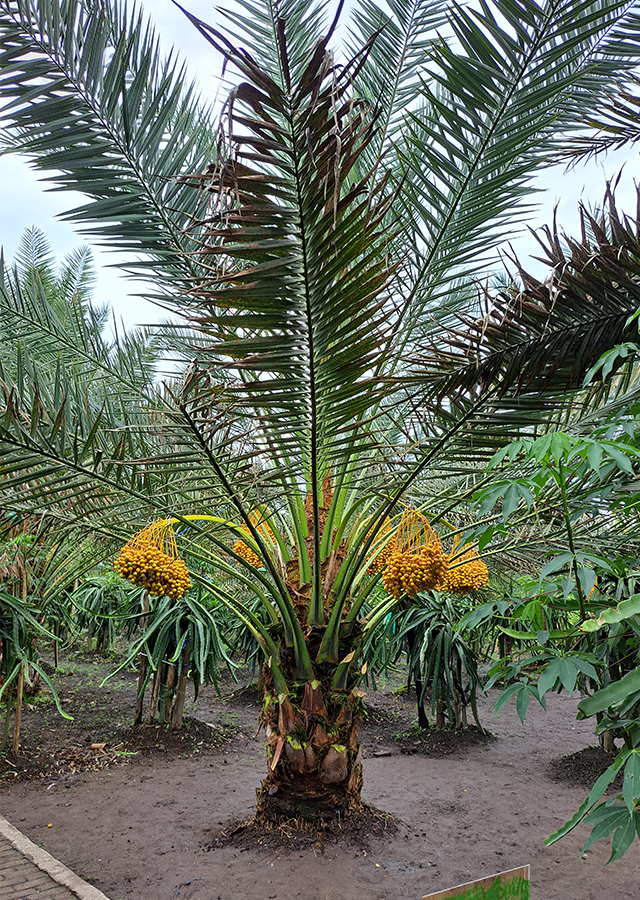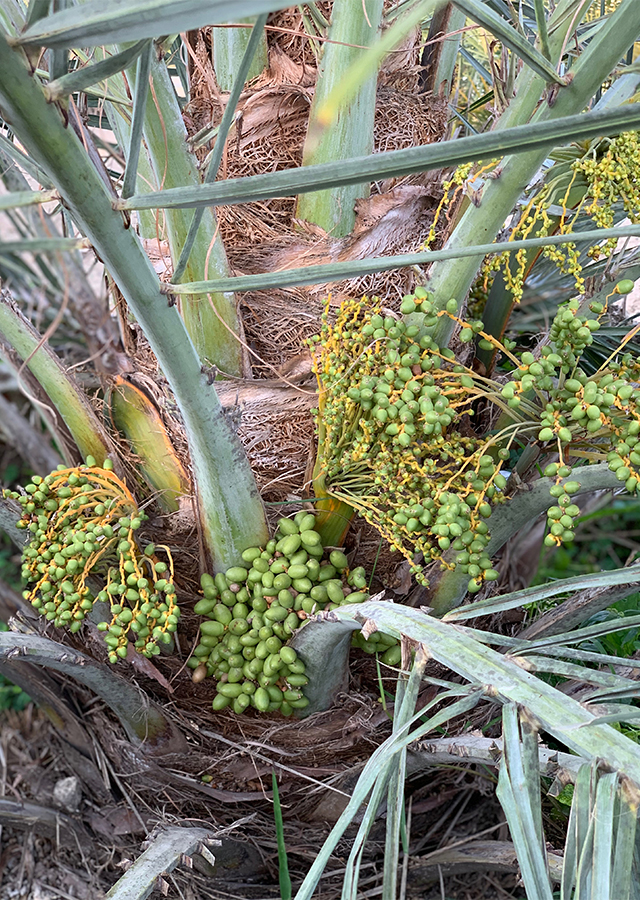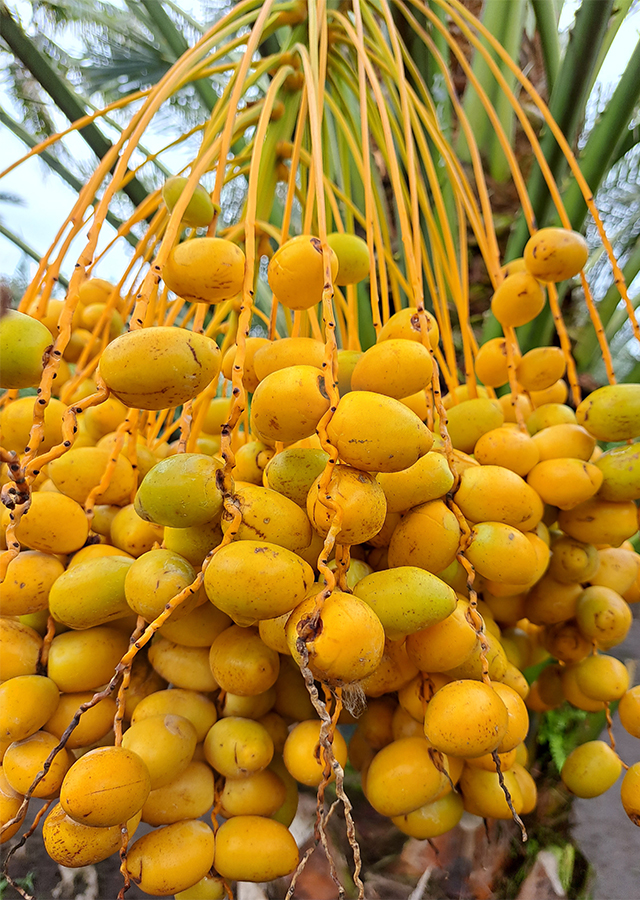Traditional Herbs from Phoenix dactylifera
relieve_alcoholic_drunkenness
- Prepare enough dates.
- Soak it in water, wait a few moments.
- Drink the soaking water to relieve alcohol hangovers.
dysentery
- Prepare enough date pulp\u00a0." ,"Eat the flesh of dates.
- The sweet flesh of dates is useful for dysentery.
What is Phoenix dactylifera Looks like??



Parts of Phoenix dactylifera that could be used
- Seed
- Fruit
- Latex
Phoenix dactylifera Distribution
Dates are believed to be a plant that grows in three places, namely the banks of the Nile, the Euphrates, Ancient Egypt and Mesopotamia. Arabs know it as the 'Tree of Life', because it is considered the oldest cultivated fruit tree that has many benefits. It has been cultivated in the Middle East since at least 6000 BC. Date palm is the most popular tree, especially in arid regions such as West Asia and North Africa. This plant has various benefits as an ornamental plant, fruit producing plant, vegetable (apical shoots), source of fiber, source of ingredients, medicinal plant, plant for reforestation of land affected by salt (in the Mediterranean region), material in construction. Dates produce fruit that can be consumed fresh, dried or used to add sweetness to various foods. It is usually the main food when breaking the fast and is believed to be able to fill energy and revitalize the body instantly. Various parts of this plant are also widely used in traditional medicine to treat various disorders. Based on research, it is known that dates are potentially safe, effective and have important medicinal value and benefits. In the cosmetics industry, dates also have various benefits, including the fruit, leaves and seeds which can be used as ingredients in cosmetic preparations as a moisturizer, skin conditioner, emollient, skin protector and mask ingredient. People have also used date seeds to increase the growth of livestock, usually by including them in animal feed. Apart from that, people also usually use date palm leaves to make roofs and walls of huts, leaf fibers and bark to make ropes, baskets, hats and mats, and dry leaves with stiff wooden rachis as fences.Agroecology of Phoenix dactylifera
Date palm is a plant from dry areas in the tropics, where dates are found at altitudes of up to 1,500 m above sea level. It requires hot, dry conditions to bear fruit, and fruit does not form easily in colder or more humid climates. It grows best in areas where annual daytime temperatures are in the range of 26 - 45 °C, but can tolerate 10 - 52 °C. When dormant, plants can survive temperatures down to about -15 °C, but leaves and young growth can be severely damaged at -4 °C. This species also prefers areas with average annual rainfall in the range of 200 - 300 mm, but tolerates 100 - 400 mm. Its need for water must be met with groundwater (tree roots can reach a depth of 2 - 6 m) or irrigation. Date palms can grow well in full sunlight, even when small. This species likes soil with a soil acidity (pH) in the range of 6.5 - 8, and tolerates a pH of 6 - 8.5. Date palms are also tolerant of salt or salty soil and various types of soil.
Morphology of Phoenix dactylifera
- Single, slender, straight stem, with a distinct petiolar scar.
- Pinarate leaves containing about 150 leaflets bearing spines on the petioles. Leaflets are narrow-lanceolate, stiff and greyish.
- Flowers are small, yellowish and borne singly. Inflorescences are produced between the leaves, with a single bract at the base.
- The fruit is cylindrical or oblong-elliptical, with flesh surrounding the hard seeds inside. Ripe fruit is golden yellow to reddish brown.
- Single seed, hard, brown.
Cultivation of Phoenix dactylifera
- Plant propagation is through seeds. However, before sowing, soak the seeds first for 24 hours in warm water and sow them in a container. Germination usually occurs in 2 - 3 months.
- Plant propagation is through seedlings. Plants can start bearing fruit in 2 - 4 years and usually reaches full production at 5 - 8 years, although productivity can increase up to 9 - 15 years.
- Pollination is very important for producing good fruit, therefore, pollen is usually artificially introduced into female flowers by cutting off male inflorescences and strategically placing them within female inflorescences. Male trees are planted with females in a ratio of approximately 1:50 to provide sufficient pollen.
Phoenix dactylifera, more details :
Chemical Content of Phoenix dactyliferaPhenolic compounds (cinnamic acids (caffeic acid, p-coumaric acid, ferulic acid, m-coumaric, o-coumaric acid, and their derivatives such as dactyliferic acid), hydroxylated benzoic acid derivatives (gallic acid, protocatechuic acid, p-hydroxybenzoic acid, vanillic)), flavonoid glycosides (luteolin, methyl luteolin, quercetin, and methyl quercetin), flavanols (catechins, epicatechins), sterols and/or triterpenes, tannins, saponins, α-amyrin, alkaloids, coumarins, phytosterol and phytoestrogen compounds, oleic, lauric, palmitic, capric, myristic, myristol, palmitoleic, stearic acids , linoleic, and linolenic.
Benefits of Phoenix dactylifera
Treats respiratory diseases (asthma), diarrhea and dysentery, stomach ulcers, skin disorders, cardiovascular disorders, colds, cystitis, gonorrhea, edema, colds, sore throats, toothaches, reduces fever, increases fertility in women, fights cancer, good for bone and tooth growth, optimizing fetal growth, improving breast milk quality, maintaining the fitness and energy of nursing mothers, treating memory disorders, loss of consciousness and nervous disorders, inflammation, paralysis, relieving alcohol hangovers, relieving headaches and hemicrania, relieving gas stomach and pain especially after heavy meals, speeds up the recovery period from fever and smallpox, prevents constipation. Has activity as an antioxidant, antitumor, antidiabetic, anti-inflammatory, antiulcer.
Simplisia of Phoenix dactylifera
- Prepare the date seeds,\u00a0wash them thoroughly with running water\u00a0then drain them.
- Dry them in direct sunlight for several days or in an oven at a temperature\u00a040 \u00b0C until the moisture content\u00a010%.
- Phone them until they become powder.
- Store simplicia powder in plastic or a clean, airtight container.
Another Facts for Phoenix dactylifera :
Synonym of Phoenix dactyliferaPalma dactylifera (L.) Mill., Phoenix excelsior Cav., Zamia pallida Salibs.
Habitus of Phoenix dactylifera
Palm. Palm, single-stemmed, grows to a height of about 15 - 40 m
Habitat of Phoenix dactylifera
- Riverside
- Land
No comments:
Post a Comment